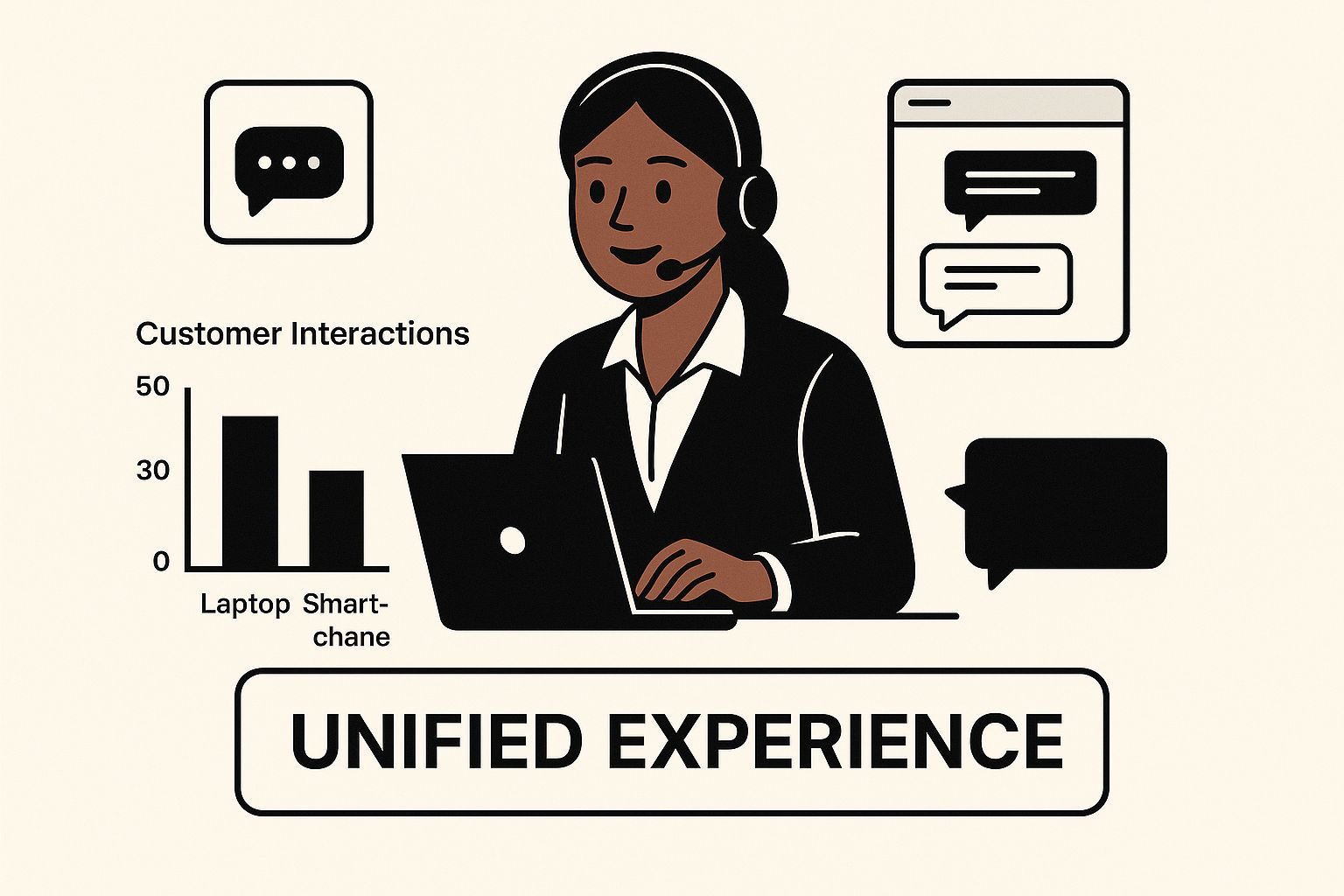Demystifying Omnichannel Contact Center Technology
An omnichannel contact center provides more than just multiple communication channels like phone, email, or chat. It integrates these channels into a single, unified platform, creating a seamless and consistent customer experience. Whether a customer interacts via WhatsApp, social media, or a traditional phone call, the experience remains personalized and connected. This integrated approach gives agents a complete view of the customer journey, enabling them to provide more effective and empathetic support.
Core Components of an Omnichannel Contact Center
Several key technologies combine to deliver this unified experience. A crucial element is the unified agent desktop, which provides agents with a single interface for managing interactions across all channels. This eliminates the need to switch between different systems, streamlining workflows and allowing agents to focus on delivering excellent service. Another essential component is a centralized customer data platform. This central repository collects customer information from all interaction points, building a comprehensive customer profile accessible to agents in real-time. Having this holistic view empowers agents with the context needed to personalize interactions and resolve issues efficiently.
Integration Challenges and Solutions
Implementing an omnichannel contact center can present integration challenges, despite its clear benefits. Many organizations face difficulties connecting legacy systems with newer communication channels. However, the adoption of omnichannel contact centers is a growing trend in the Middle East. The Middle East call center market, driven by these omnichannel strategies, was valued at USD 6309.68 million in 2024 and is projected to expand at a CAGR of 12.2% between 2025 and 2033. Find more detailed statistics here This growth underscores the increasing importance of seamless customer interactions across various channels, driven by organizations recognizing the value of a personalized customer journey. For further insights, see this article on mastering omnichannels in call centers. Fortunately, modern platforms offer flexible integration solutions, including APIs and pre-built connectors, enabling organizations to gradually unify their customer touchpoints.
Regional Considerations for the AE Region
Cultural nuances significantly influence customer expectations within the AE region. Organizations must consider language preferences, communication styles, and regional sensitivities when developing their omnichannel strategy. Offering support in both Arabic and English is often crucial. Understanding preferred communication channels within specific demographics can greatly impact customer satisfaction. By adapting the omnichannel experience to the unique needs of the AE customer, businesses can strengthen customer relationships and foster loyalty.
Cloud Revolution: Transforming Middle East Contact Centers
The customer service landscape in the Middle East is evolving. Traditional on-premises contact center infrastructure is being replaced by the adaptable and scalable nature of the cloud. Progressive organizations are adopting Contact Center as a Service (CCaaS) to meet the increasing expectations of today’s connected customers. This shift enables businesses to respond to regional communication preferences with greater agility, all while consistently delivering excellent service.
Advantages of CCaaS in the Middle East
CCaaS platforms offer several key advantages for businesses in the Middle East and Africa (MEA) region. They provide the scalability needed to manage peak demand, which is especially important during high-traffic periods like Ramadan or major shopping events. This flexibility guarantees customers receive timely support, eliminating long wait times.
Furthermore, CCaaS solutions support remote work, enabling agents to provide support from anywhere with internet access. This flexibility is essential for business continuity and allows organizations to build geographically diverse teams.

This infographic depicts a customer service agent seamlessly interacting with customers across various digital channels, including laptops, smartphones, and chat, demonstrating a unified customer experience. This visualization highlights the seamless experience customers receive, regardless of their preferred communication method, underscoring the effectiveness of an omnichannel strategy.
Addressing Regional Considerations
While the benefits of cloud-based omnichannel contact centers are substantial, adoption in the Middle East requires careful consideration of regional nuances. Data sovereignty is a primary concern. Businesses must comply with local regulations regarding data storage and processing.
Infrastructure readiness is another key factor. Reliable internet access is essential for seamless operation. You might be interested in: Xcally UAE Omni-Channel Contact Center. The market is rapidly developing, and the growing availability of high-speed internet and cloud services across the region is facilitating increased cloud adoption.
The CCaaS market in the Middle East is experiencing substantial growth. By 2025, the market was projected to reach USD 479.3 million. It is expected to grow to USD 1,122.9 million by 2032, a CAGR of 12.9%. Explore this topic further. This growth is fueled by the increasing adoption of cloud-based solutions offering advanced features, including omnichannel support and AI-powered chatbots. For deeper insights into how AI enhances omnichannel customer support, explore Omnichannel AI Customer Support.
To better understand the differences between cloud-based and on-premises solutions, let's examine a comparison table:
The following table compares key differences between cloud-based and traditional on-premises omnichannel contact center solutions across multiple factors.
| Feature/Aspect | Cloud-Based Solutions | On-Premises Solutions | Best For |
|---|---|---|---|
| Scalability | Easily scalable to meet fluctuating demand | Requires significant hardware investment for scaling | Businesses with fluctuating call volumes or seasonal peaks |
| Cost | Subscription-based model, lower upfront costs | High upfront investment in hardware and software | Businesses with limited initial capital |
| Maintenance | Managed by the provider | Requires dedicated IT staff for maintenance | Businesses without extensive IT resources |
| Deployment | Faster deployment times | Longer implementation process | Businesses needing a quick setup |
| Data Security | Security measures managed by the provider | Requires in-house security management | Businesses looking for simplified security management |
| Control | Less direct control over infrastructure | Full control over infrastructure | Businesses requiring maximum control over their systems |
This table highlights the advantages of cloud-based solutions in terms of scalability, cost-effectiveness, and ease of maintenance. On-premises solutions offer greater control, but come with higher upfront costs and more complex maintenance requirements.
Overcoming Implementation Hurdles
Many organizations have successfully addressed implementation challenges and achieved exceptional customer experiences. They have done so through careful planning, partnering with experienced providers, and focusing on phased implementation.
Starting with a smaller pilot project can help identify and address potential issues before a full-scale deployment. By learning from early adopters, businesses can implement robust and effective cloud-based omnichannel contact centers tailored to the specific needs of the Middle Eastern market.
AI Integration: The Future of Middle East Customer Engagement

Artificial intelligence is rapidly changing how omnichannel contact centers operate, especially in the Middle East. This evolution is more significant than simple chatbot integration, profoundly impacting how businesses engage with their customers. Leading organizations are adopting AI-powered solutions that not only respect important cultural nuances but also provide exceptional service 24/7.
Beyond Chatbots: Practical AI Applications
While chatbots offer a basic level of automated support, the real power of AI lies in more sophisticated applications. For instance, sentiment analysis designed for regional languages like Arabic and its various dialects can offer valuable insights into customer emotions.
This understanding allows agents to respond with increased empathy and effectively address underlying issues. Furthermore, predictive routing, much like a smart traffic controller, directs customer inquiries to the most appropriate agent.
This routing is based on individual customer preferences and the complexity of their request, ensuring efficient and effective handling.
Empowering Agents, Not Replacing Them
The integration of AI in the omnichannel contact center isn't about replacing human agents. Instead, it's about providing them with the tools they need to elevate the customer experience. Agent assistance tools offer real-time information, suggested responses, and ready access to knowledge bases.
This empowerment frees agents to focus on complex problem-solving and cultivate stronger relationships with customers. This approach emphasizes the human element, leading to more personalized and efficient support.
Navigating the Challenges of AI Adoption
Implementing AI in the Middle East presents specific challenges. Supporting the diverse range of dialects within the region's languages can be complex, and cultural considerations play a significant role in successful deployment. The rise of omnichannel contact centers in the Middle East is directly related to the progress in AI and cloud computing.
A significant portion of contact center managers in the region, mirroring global trends, see AI as vital for providing continuous omnichannel support. Learn more about this research. Overcoming these obstacles requires careful planning, effective collaboration with technology partners, and a thorough understanding of the local market. For more information on this developing field, explore the potential of AI integration.
Embracing the Future of Customer Engagement
Successfully integrating AI into an omnichannel contact center requires a strategic approach. This involves choosing the right technology, providing effective agent training, and continuously optimizing AI-driven processes.
By recognizing the specific needs of the Middle Eastern market, businesses can unlock the full potential of AI. This, in turn, will allow them to deliver outstanding customer experiences that build loyalty and stimulate growth. Thoughtful implementation of AI ensures businesses not only meet customer expectations but exceed them in today’s competitive landscape.
Crafting an Omnichannel Strategy That Resonates Locally

Building a successful omnichannel contact center in the Middle East requires more than just the right technology. It demands a deep understanding of the region's unique customer expectations and behaviors. This means developing a strategy that aligns with local communication preferences while delivering seamless experiences across all channels.
Mapping the Customer Journey in the Middle East
Understanding the typical customer journey within the region is crucial. This involves identifying preferred channels for different customer segments and mapping their interactions with your business. For example, younger demographics might prefer instant messaging apps like WhatsApp, while older generations may still favor traditional phone calls.
By mapping these journeys, businesses can optimize each touchpoint for a personalized and efficient experience. This understanding also allows for effective resource allocation and a tailored service approach.
Balancing Digital with Traditional Channels
While digital adoption is rapidly increasing across the Middle East, traditional channels remain important. Finding the right balance between embracing new technologies and supporting existing preferences is key.
This means offering a mix of digital and traditional communication options to cater to the diverse needs of the regional customer base. This blended approach ensures accessibility for all customers, regardless of their technological comfort level.
To illustrate the varying channel preferences across the Middle East, let's examine some statistics from key markets. The following table provides a glimpse into this diverse landscape, highlighting the importance of a balanced omnichannel approach.
Channel Preference Statistics in Key Middle Eastern Markets
This table presents data on customer channel preferences across different countries in the Middle East, helping businesses prioritize their omnichannel investments.
| Country | Voice Preference (%) | Digital Channels (%) | Social Media (%) | Messaging Apps (%) |
|---|---|---|---|---|
| Saudi Arabia | 45 | 35 | 10 | 10 |
| UAE | 40 | 40 | 15 | 5 |
| Egypt | 55 | 25 | 10 | 10 |
| Kuwait | 35 | 45 | 10 | 10 |
These statistics are illustrative and may not reflect current real-time data. Further research is recommended for specific market insights.
As the table demonstrates, voice remains a significant channel, especially in Egypt. However, digital channels, including social media and messaging apps, are gaining traction, particularly in markets like the UAE and Kuwait. This reinforces the need for a flexible omnichannel strategy that adapts to evolving customer behaviors.
Navigating Multilingual and Cultural Nuances
The Middle East is a diverse region with multiple languages and distinct cultural norms. Navigating these nuances is vital for providing excellent customer service. This includes offering support in multiple languages, especially Arabic and English.
Cultural sensitivity training for agents is also essential. This ensures interactions are respectful and appropriate, fostering positive customer relationships.
Staffing and Training for Omnichannel Success
Building a high-performing omnichannel team requires careful staffing and training. Recruiting agents with strong communication skills and cultural awareness is paramount.
Thorough training on the omnichannel platform and best practices for each communication channel is equally important. This empowers agents to provide consistent, high-quality service.
Measuring Performance in a Regional Context
Measuring omnichannel success requires regionally tailored metrics. This involves focusing on KPIs that reflect customer satisfaction, loyalty, and regional business objectives. For example, measuring customer effort score (CES) can provide valuable insights.
Additionally, tracking resolution rates across different channels can identify areas for improvement. This ensures service levels align with local market expectations.
Overcoming Regional Roadblocks to Omnichannel Excellence
Implementing an omnichannel contact center in the Middle East offers significant potential. However, unique regional factors can present challenges. Let's explore these obstacles and discuss practical solutions for achieving omnichannel excellence in the AE region.
Legacy System Integration
Many organizations in the Middle East rely on legacy systems. These older systems often struggle to integrate with modern omnichannel platforms, creating data silos and hindering seamless information flow. A phased integration approach is a practical solution. Start by integrating essential systems and gradually incorporate others. This minimizes disruption and allows teams to adapt progressively.
Organizational Resistance to Change
Introducing new technologies often encounters internal resistance. Employees accustomed to traditional methods may hesitate to embrace new processes. Clear communication and comprehensive training are essential. Showcase the benefits of the omnichannel approach and provide thorough training to empower staff with the necessary skills. This reduces anxiety and fosters smoother transitions.
Infrastructure Limitations
Reliable internet access is crucial for cloud-based solutions. However, connectivity can be inconsistent in certain areas within the AE region. Assessing infrastructure readiness is critical before implementation. Hybrid solutions combining cloud and on-premises infrastructure can accommodate connectivity limitations, ensuring consistent service delivery.
Building Stakeholder Support
Securing stakeholder buy-in is vital for successful implementation. Presenting a compelling business case demonstrating return on investment (ROI) is essential. Develop ROI models tailored to Middle Eastern business environments. Highlight potential cost savings, improved customer satisfaction, and increased efficiency. Quantifiable data effectively demonstrates the value proposition.
Phased Implementation for Success
Ambitious, large-scale overhauls can be risky. A phased implementation allows organizations to test and refine their strategy incrementally. Start with a pilot project involving a limited number of channels. Gradually expand as the team gains experience and confidence. This measured approach minimizes risk and enables adjustments based on real-world feedback.
Navigating Regulatory Compliance
Data privacy and security regulations vary across the Middle East. Ensuring compliance with local regulations is paramount. This not only avoids legal issues but also maintains customer trust. Consulting with legal experts is crucial to ensure adherence to all relevant data protection laws within your operational region.
Addressing Digital Maturity
Organizations across the Middle East have varying levels of digital maturity. Implementing an omnichannel contact center requires a customized approach. Tailor the implementation strategy to align with the organization's existing infrastructure and technical capabilities. This ensures a smooth transition and maximizes the effectiveness of the new system.
By acknowledging these regional challenges and implementing practical solutions, businesses in the AE region can harness the power of the omnichannel contact center. This results in improved customer experiences, increased efficiency, and ultimately, greater business success. Cloud Move, with its experience deploying customized contact center solutions across the Middle East, understands these regional nuances and can help navigate these complexities. Learn more about Cloud Move's expertise.
Measuring What Matters: Omnichannel Success Metrics
Beyond simply offering multiple communication channels, true omnichannel success in the Middle East depends on measuring what truly matters to customers and businesses. This goes beyond basic metrics and requires a comprehensive framework for evaluating performance across all channels, customer segments, and business objectives.
Key Performance Indicators (KPIs) for the AE Region
Certain KPIs are especially relevant for gauging omnichannel success in the Middle East. Customer satisfaction (CSAT), measured through surveys and feedback, offers direct insight into customer perceptions of their interactions. Customer effort score (CES) reveals how easily customers can resolve their issues. This is critical in a region that values quick and efficient service. Finally, first contact resolution (FCR) reflects the contact center's efficiency in addressing customer needs. A high FCR rate indicates that customer problems are resolved quickly and effectively.
Building a Holistic Reporting System
Effective measurement requires a robust reporting system that provides a clear view of performance across all channels. This system should consolidate data from various sources, offering a holistic view of the customer journey. However, collecting too much data can be counterproductive. The focus should be on gathering relevant data and presenting it in actionable formats. This means dashboards that clearly highlight key trends, agent performance, and areas for improvement.
Advanced Analytics for Enhanced Insights
You might be interested in: Contact Center KPIs. Beyond standard reporting, exploring advanced analytics can yield valuable insights. Journey analytics, for example, maps the entire customer journey, revealing pain points and areas for optimization across all touchpoints. This helps businesses understand how customers interact with their brand across channels and identify opportunities to improve the overall experience. This holistic perspective is particularly important in the AE region, where cultural nuances can significantly influence customer behavior.
Regional Benchmarks and Continuous Improvement
Understanding how your contact center performance stacks up against regional peers is valuable. Regional benchmarks provide essential context and help identify areas where your business excels or needs improvement. This competitive analysis helps drive continuous improvement and ensures your omnichannel strategy remains effective in a dynamic market. Ongoing optimization ensures your business stays ahead of evolving customer expectations and maintains a competitive edge.
For an effective omnichannel strategy in the Middle East, focus on understanding regional customer expectations and measuring performance with relevant KPIs. Optimize your strategies based on these insights to enhance customer satisfaction, efficiency, and ultimately, business growth. Discover how Cloud Move can help your business achieve these goals with its omnichannel solutions. Explore Cloud Move's offerings and request a free demo today!




